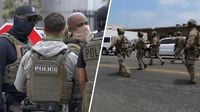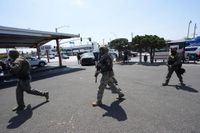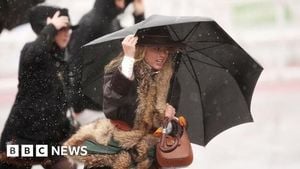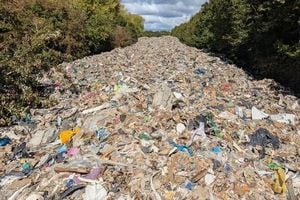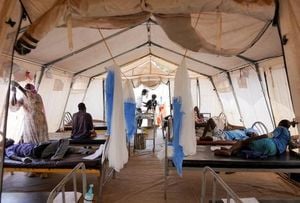On September 8, 2025, the U.S. Supreme Court handed down a decision that has sent shockwaves through Los Angeles and beyond, upending years of legal progress on racial profiling and immigrant rights. In a 6-3 vote that split along ideological lines, the Court’s conservative majority lifted a federal injunction that had barred Immigration and Customs Enforcement (ICE) agents from stopping individuals in Los Angeles solely on the basis of apparent race, language, occupation, or location. The ruling, which is already being called historic—and, by many, deeply troubling—has immediate and far-reaching consequences for Latino, Black, and LGBTQ+ communities in Southern California.
The case, Noem v. Perdomo, stemmed from a July 2025 order by U.S. District Judge Maame E. Frimpong, who found a “mountain of evidence” that ICE’s aggressive enforcement tactics violated constitutional rights. Her injunction had protected nearly 20 million people in Los Angeles and surrounding counties, almost half of whom identify as Hispanic or Latino. But with the Supreme Court’s decision, those protections are now gone, at least temporarily, and ICE agents have resumed what critics describe as racially targeted raids and roving patrols.
According to the Associated Press, since June 6, 2025, ICE has made more than 5,210 immigration arrests in the Los Angeles area. The Department of Homeland Security (DHS) praised these actions, promising to “continue to FLOOD THE ZONE in Los Angeles” following the high court’s ruling. The agency’s lead commander, Gregory Bovino, was singled out for his “success in getting the worst of the worst out of the Los Angeles region.” Yet, for many residents and advocates, these numbers are not a sign of progress, but of distress.
The Supreme Court majority, led by Justice Brett Kavanaugh, did not offer a detailed explanation for its decision, as is typical on the court’s emergency docket. However, Kavanaugh’s concurrence argued that the lower court’s restrictions would “inevitably chill lawful immigration enforcement efforts.” He wrote, “The prospect of such after-the-fact judicial second-guessing and contempt proceedings will inevitably chill lawful immigration enforcement efforts.” Kavanaugh further suggested that stops based on apparent ethnicity could be a “relevant factor” in determining reasonable suspicion for questioning, and claimed that for those legally in the country, “the questioning in those circumstances is typically brief, and those individuals may promptly go free after making clear to the immigration officers that they are U.S. citizens or otherwise legally in the U.S.”
This reasoning has been met with fierce criticism. Justice Sonia Sotomayor, writing for the dissent and joined by Justices Elena Kagan and Ketanji Brown Jackson, issued a stinging rebuke: “Countless people in the Los Angeles area have been grabbed, thrown to the ground, and handcuffed simply because of their looks, their accents, and the fact they make a living by doing manual labor. Today, the Court needlessly subjects countless more to these exact same indignities.” She warned that the government “has all but declared that all Latinos, U.S. citizens or not, who work low wage jobs are fair game to be seized at any time, taken away from work, and held until they provide proof of their legal status to the agents’ satisfaction.”
The practical impact of the ruling has already been felt on the streets. According to the lawsuit, plaintiffs included both immigrants and U.S. citizens, such as Los Angeles resident Brian Gavidia, who was shown in a June 13 video being seized by federal agents and pressed against a metal fence while yelling: “I was born here in the States. East LA, bro!” Gavidia, a U.S. citizen, was released after about 20 minutes, but his experience is emblematic of the sweeping nature of ICE’s tactics. Another plaintiff, Pedro Vasquez Perdomo, recounted, “I was treated like I didn’t matter—locked up, cold, hungry, and without a lawyer. Now, the Supreme Court says that’s okay? That’s not justice. That’s racism with a badge.”
Local officials have not minced words in their condemnation. Los Angeles Mayor Karen Bass stated, “This isn’t just an attack on the people of Los Angeles. This is an attack on every person in this city, and in every city in this country.” California Attorney General Rob Bonta highlighted the apparent contradiction in the Court’s recent decisions: “They prevent the use of race (in college admissions) to tackle discrimination but allow the use of race to potentially discriminate.” Governor Gavin Newsom warned that the order would give agents “wide latitude to make stops—including U.S. citizens and children, to deliberately harm California’s families and small businesses.”
The decision has drawn the ire of legal advocacy organizations nationwide. The Immigrant Law Center of Minnesota (ILCM) called the ruling a “trampling of Fourth Amendment and due process principles, institutionalizing racism and xenophobia.” In a statement, ILCM said, “It gives explicit license for federal agencies to harass, abuse, and traumatize people based on their presumed race, ethnicity, job, location, or language, effectively pushing the United States deeper into authoritarianism.” The organization also placed the decision in historical context, noting that “the U.S. immigration system has always considered race, whether through racial and national immigration bans, country quotas, or definitions of whiteness.”
GLAD Law’s Executive Director, Ricardo Martinez, was equally blunt: “We are outraged by the U.S. Supreme Court’s decision to uphold the authority of Immigration and Customs Enforcement agents to indiscriminately target people in Los Angeles simply for speaking Spanish or looking Latino. This ruling reads as a blatant endorsement of racial profiling and a green light for state-sanctioned harassment. It tells our communities that the mere fact of our existence—our language, our skin—is grounds for suspicion and punishment. This is not justice.” Martinez emphasized the disproportionate impact on LGBTQ+ immigrants and people of color, warning that the decision “further jeopardizes our safety and dignity.”
Supporters of the ruling, including Attorney General Pam Bondi and federal border czar Tom Homan, have applauded what they see as a restoration of law enforcement discretion. Bondi posted on social media, “Now, ICE can continue carrying out roving patrols in California without judicial micromanagement.” Federal attorneys maintain that ICE targets people based on illegal presence in the U.S., not skin color or ethnicity, but acknowledge that “at least some of those factors” may be used in combination with others.
The legal battle is far from over. The lawsuit challenging ICE’s practices will continue in California, with a hearing set for September 24. Meanwhile, immigrant advocacy groups are urging residents to educate themselves, participate in bystander trainings, and join court observer projects to protect their communities. The Immigrant Law Center of Minnesota called on the public: “Let history remind us not to stand idly by.”
For many in Los Angeles, the Supreme Court’s decision feels like a turning point—a moment when the promise of equal protection under the law has been thrown into question. As the legal fight continues, the city’s residents are left to grapple with the reality of living under a regime where language, skin color, or simply being in the wrong place at the wrong time can make anyone a target.
